Subscribe now and get the latest podcast releases delivered straight to your inbox.
What does HubSpot cost?
With three hubs, each with four distinct tiers, the cost of HubSpot can vary widely. There are free versions of all products, but they offer limited functionality for a growing business. To start out, expect to pay a minimum of $50/month for each hub (sales, marketing, and/or service) with additional fees if you have a high number of contacts or larger teams.
So, you’re evaluating HubSpot for your marketing, sales, or service teams. (Or some combination of the three!).
Trust me when I say that HubSpot is a wonderful tool for executing and tracking your inbound marketing and sales strategies. But between the different offerings and tiers, plus add-ons and contact tier considerations — there’s a lot to navigate and evaluate when planning your investment.
It can be confusing, but for more than a decade, we’ve been helping companies of all shapes, sizes, and sectors find the best match for their marketing needs and budgets.
Below, we’ll break down everything you need to know about HubSpot pricing, and help you decide what the best package for your organization is. This includes:
- The HubSpot pricing basics: A breakdown of the different hubs and tiers
- An overview of HubSpot Marketing pricing
- An overview of HubSpot Sales pricing
- An overview of HubSpot Service pricing
HubSpot pricing basics: Hubs and tiers
HubSpot has three main software hubs: Marketing, Sales, and Service. They don’t function as separate platforms, but they are purchased separately.
Note: If you’re looking to host your entire website on the HubSpot platform, you’ll also want to check out CMS Hub, HubSpot’s content management system platform. We won’t go into that in this article, but you can learn all about it, including pricing, here.
To start with the basics, here’s a simple one-sentence explanation straight from HubSpot of what each hub does. (There is, of course, much more to this — but this will give you the general idea.):
- Marketing Hub: “Everything you need to launch effective marketing campaigns that make people interested in your business and happy to be your customer.”
- Sales Hub: “Get notified the moment a lead opens your email, track every interaction automatically, and organize all your activities in one place with HubSpot’s sales software. Start for free, and upgrade as you grow.”
- Service Hub: “Customer service software that builds organization and efficiency into your customer service team.”
Depending on what tech tools you use currently, you may or may not have a need for multiple hubs.
Many companies start with the Marketing Hub, and once they see and experience how easy the platform is to use, start to evangelize it to their sales and service teams.
If you’re not using a digital tool for any of those three main business functions (marketing, sales, service), starting with two or three of the hubs at once can be an amazing way to bring your company into the exciting world of automation, data collection, and process optimization.
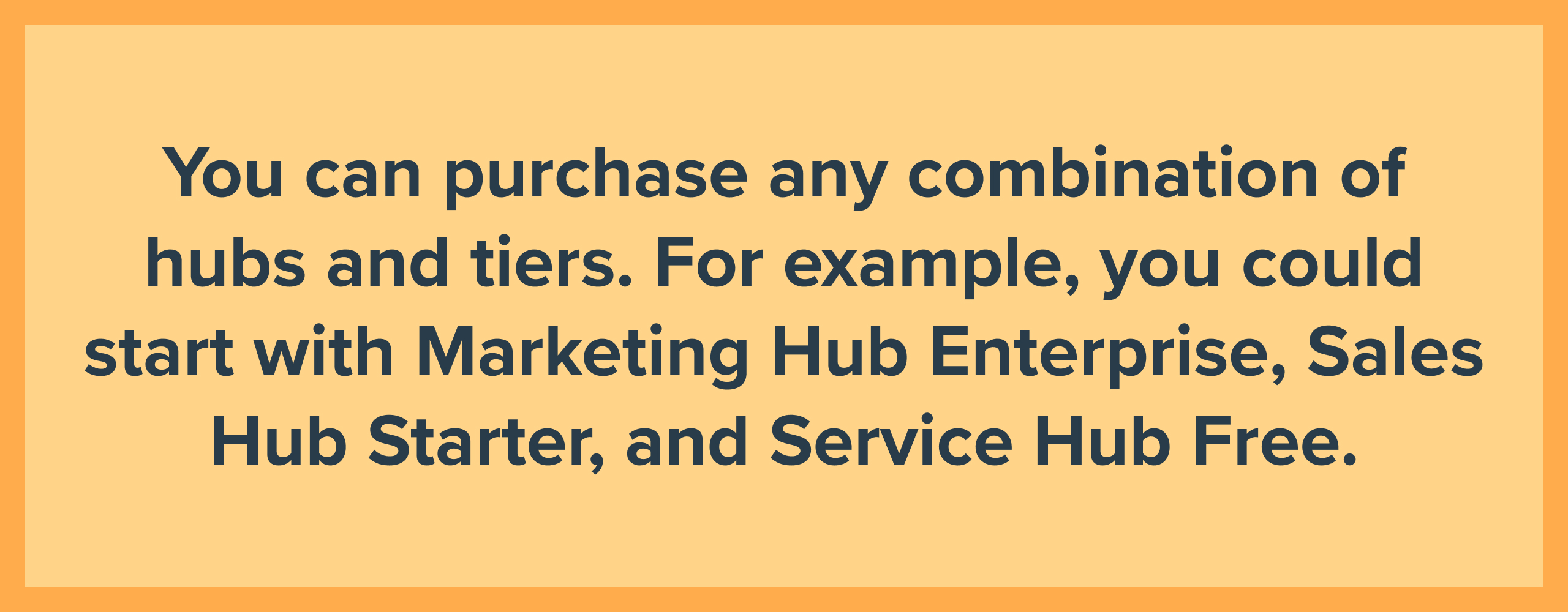
Each hub has four distinct tiers, from most basic to most sophisticated: Free, Starter, Professional, and Enterprise. As you move up tiers, you get more and more functionality and tools, along with fewer limitations.
You can purchase any combination of hubs and tiers. For example, you could start with Marketing Hub Enterprise, Sales Hub Starter, and Service Hub Free. However, HubSpot does offer a discount if you purchase the entire Growth Suite (all three hubs) at a single level.
You can also start with a lower cost level of the platform and upgrade at any time if you’re hesitant to make a commitment before getting your hands dirty in the tool for yourself.
As you upgrade, you’ll never lose any functionalities from other tiers; you’ll only add new ones.
Free-forever CRM
One of the first things you’ll see on HubSpot’s pricing page is its “Free Forever” CRM, or customer relationship management platform. The CRM serves as your contact database, where you can store an unlimited number of contacts, companies, deals, and tickets.
The main caveat to this “unlimited” storage is when you start using a paid version of the Marketing Hub. As soon as you switch to a paid Marketing Hub contract, you’ll have to pay per 1,000 contacts on an ongoing basis that are stored in your CRM. (More on this later.)
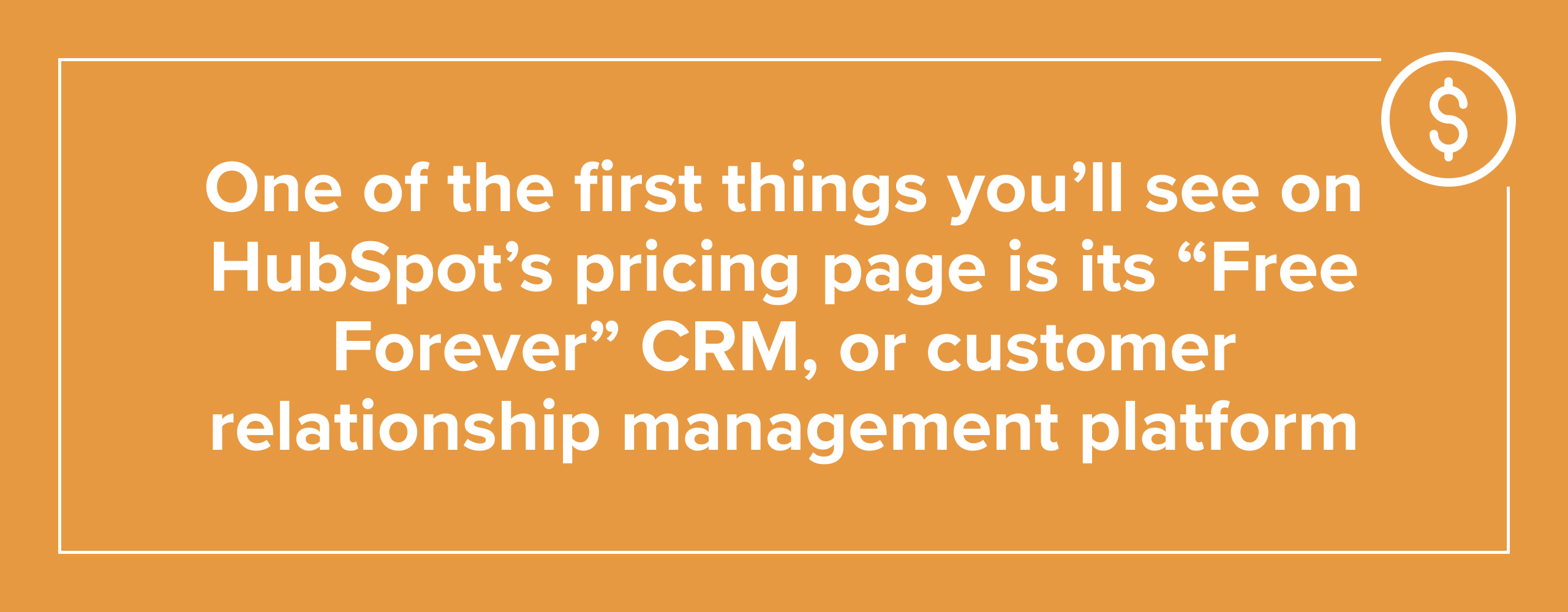 If your company has a high volume of contacts, this can be a major cost. In fact, you might pay more for your contacts than you do for the actual software subscription!
If your company has a high volume of contacts, this can be a major cost. In fact, you might pay more for your contacts than you do for the actual software subscription!
Below, we’ll break down the contact tier pricing for each level of the Marketing Hub.
Any portal you create will have the free CRM and the free version of all three hubs (Marketing, Sales, and Service). These free tools give you basic functionality to get you started with using HubSpot as a platform but are essentially a very simplified version of what you get with the paid hubs.
Sales and Service Hub ‘seats’
The pricing model is different for different hubs.
In the Marketing Hub, you have an unlimited number of users who can access the tools in your portal, but you are charged by the number of contacts you have.
With Sales and Service Hubs, any tier above free is on a pay-per-seat model. This means that in order to access certain tools and functionalities in your portal, users will need a paid seat just for them. (We’ll dive more into this later, too.)
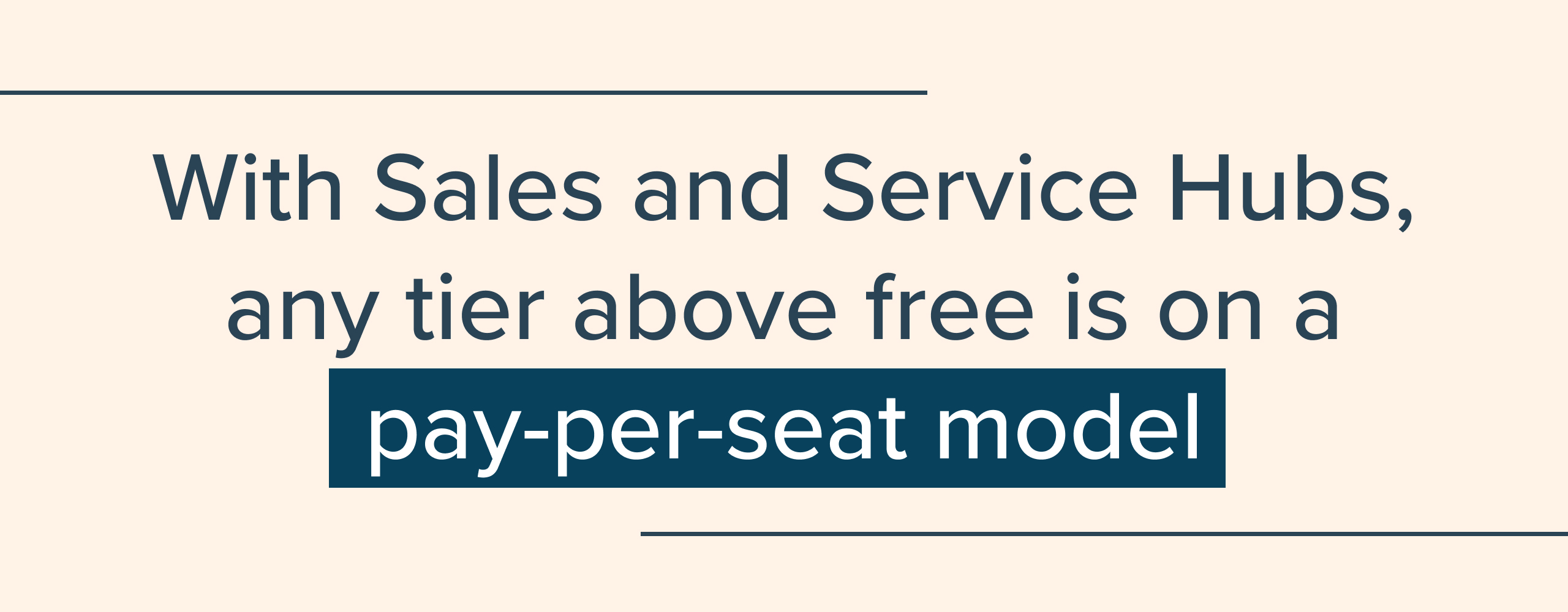
So, if you’re NOT using the Marketing Hub, and only using Sales and/or Service Hubs, you will have unlimited contacts. Just know that if you ever do start on a paid version of the Marketing Hub you will have to start paying for those contacts.
What our HubSpot pricing guide covers
Since there’s a lot to cover when it comes to all of this, we’ll organize this guide first by hub, and then break each hub down by subscription tier (Free, Starter, Professional, Enterprise).
Throughout each section, we’ll highlight important features and tools, as well as what kinds of companies or teams are a great fit for each hub and tier.
But first, here’s an over-simplified version of the cost breakdown across all the hubs and tiers:
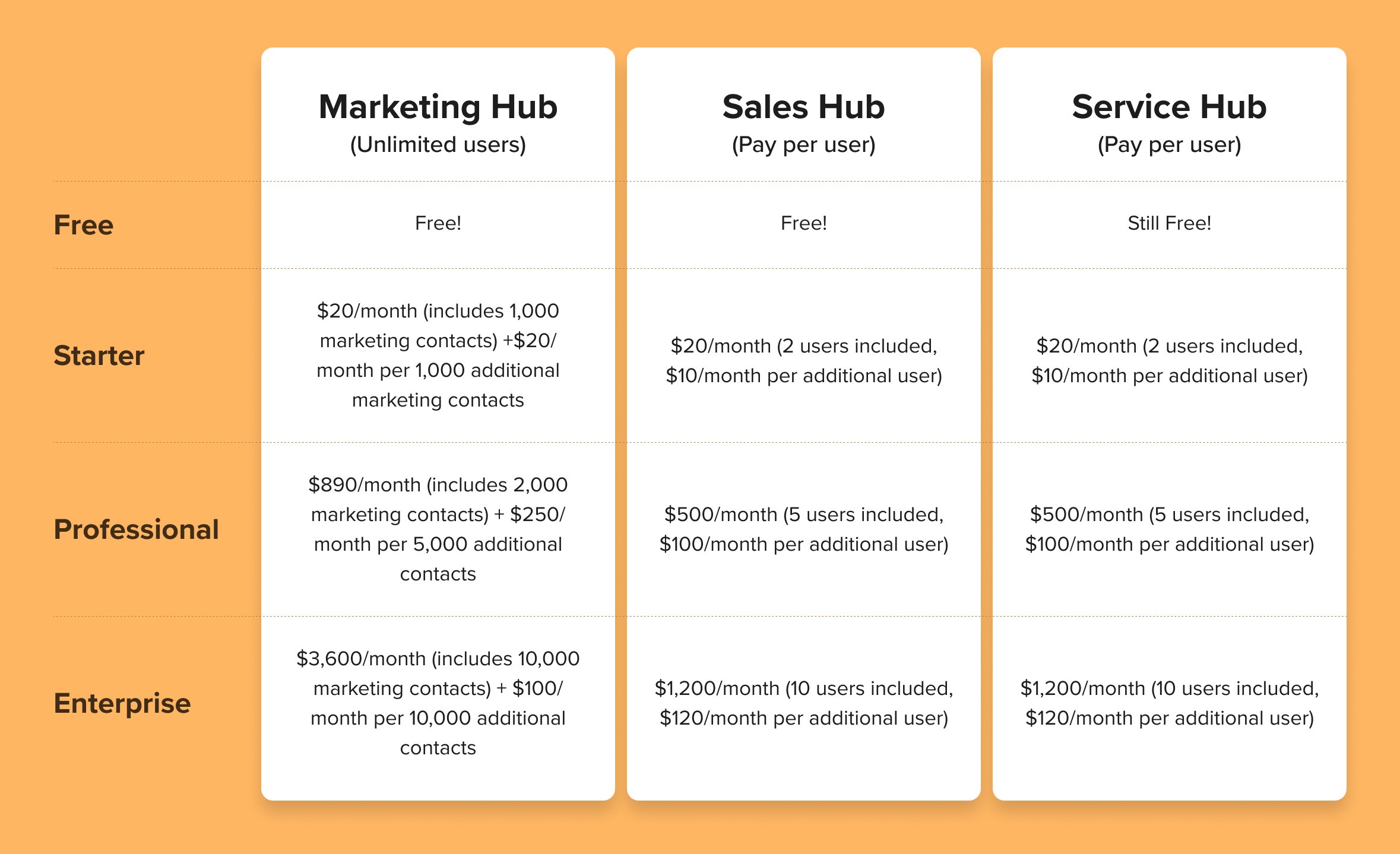
If you want to see a breakdown of pricing and calculate what you’d potentially be spending, visit HubSpot’s pricing page here.
HubSpot Marketing Hub pricing
For a super detailed breakdown of everything you could possibly want to know about HubSpot’s Marketing Hub, check out our definitive guide to HubSpot for marketing.
Free HubSpot Marketing Hub
The free tier of HubSpot Marketing Hub is the ultimate example of “try before you buy.” Much of HubSpot’s core functionality is available to you for the low low price of $0/month.
You can create basic forms, use live chat and (very) basic chatbots, manage contact records, and send out marketing emails.
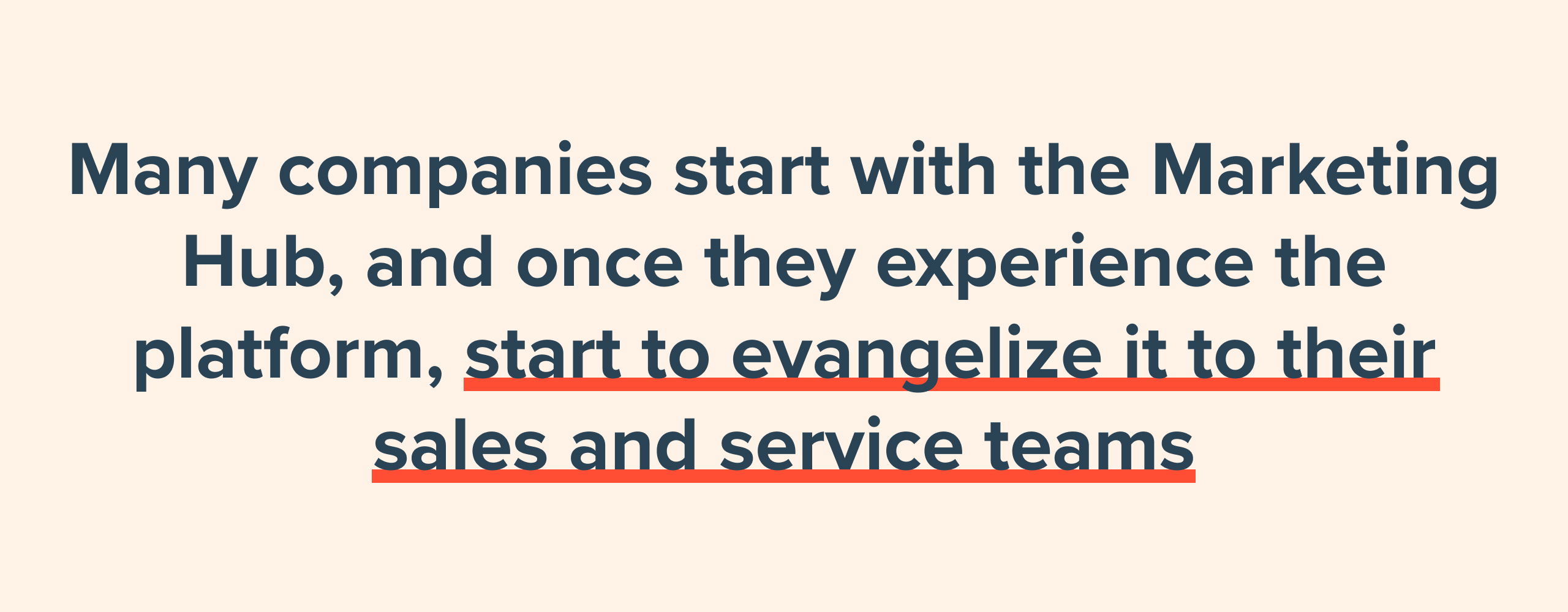
So what’s the catch? In this case, “free” does really mean free, but if you’re serious about inbound marketing, you’ll soon become frustrated by the feature limitations, such as only being able to create five dynamic lists or send 2,000 marketing emails in a month (not to mention the annoying “HubSpot” branding on all of your assets).
The only way to scale your efforts is to purchase a paid tier, but when you’re ready to take that plunge, which tier is the right fit as you grow your team?
Caveats to paid tiers
When you do decide to move forward with one of HubSpot’s paid tiers for Marketing Hub, it’s important to keep in mind that the biggest driving factor is functionality limitations and contact thresholds, not user limits.
This is great news for marketing departments with a lot of stakeholders (e.g., team members, freelancers, interns, agency experts, or members of other departments who are simply “HubSpot curious”). You can invite everyone to the HubSpot portal party and not pay an additional cent.
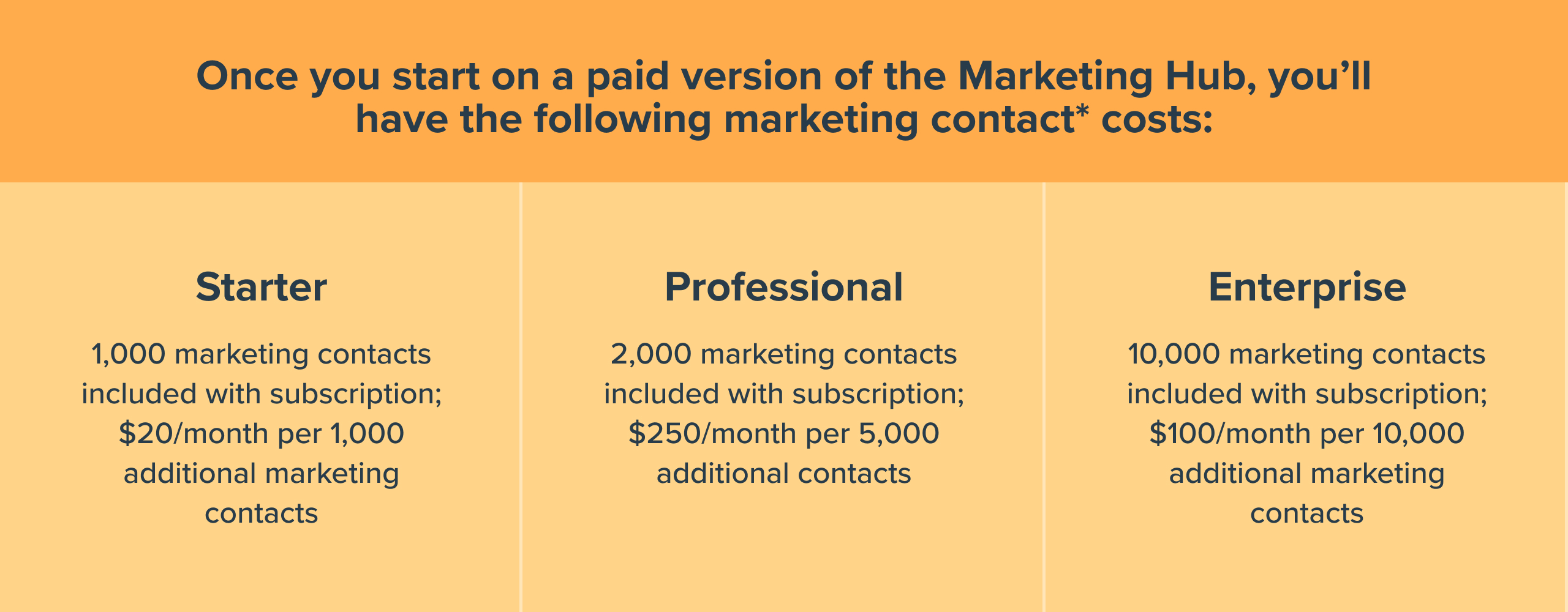
*What’s a marketing contact? In HubSpot, marketing contacts are defined as any contacts you're actively communicating with through marketing emails or ads. You can store up to 1 million non-marketing contacts in the CRM for free, but you’ll have to pay for contacts you're sending marketing emails to or targeting with ads through HubSpot, according to the pricing above.
Keep a close eye on how many marketing contacts you have in your portal. If you go over your limit, you’ll be billed the next day for the next band of contacts (1,000 for Starter, 5,000 for Pro, and 10,000 for Enterprise), and won’t be able to decrease your marketing contact tier until your next contract renewal.
Pro tip: You’ll notice that marketing contacts become significantly cheaper once you get to the Enterprise level of the Marketing Hub. If you’ve got over 60,000 contacts (or know you will in the near future), you’ll actually save money on Enterprise over Professional or Starter.
Starter ($20/month + contacts)
HubSpot’s $20/month Starter package offers three key upgrades from the free tools:
- The “HubSpot” branding on all of your assets disappears
- You get more lists and more emails (instead of five lists you get 25, and instead of 2,000 emails a month you get five times your contact limit)
- You get access to a drag-and-drop landing page builder.
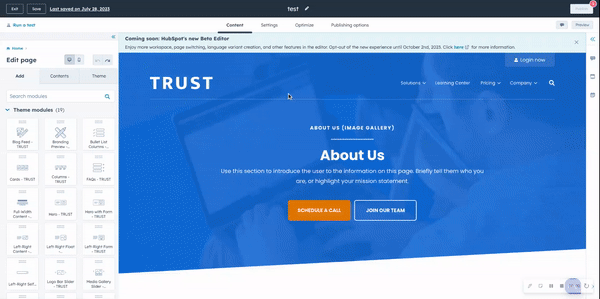
However, once you cross over into the pay-to-play arena, the most important thing to keep in mind is your contact limits.
At the free tier, you can store up to 1 million contacts in your HubSpot database at absolutely no charge, but as soon as you purchase a paid tier, you’ll quickly find that contacts come at a steep cost. The first 1,000 contacts are included in the $20 flat fee, but you'll have to pay per 1,000 contacts above your normal monthly rate (starting at $20/month per 1,000 and scaling down the more contacts you get).
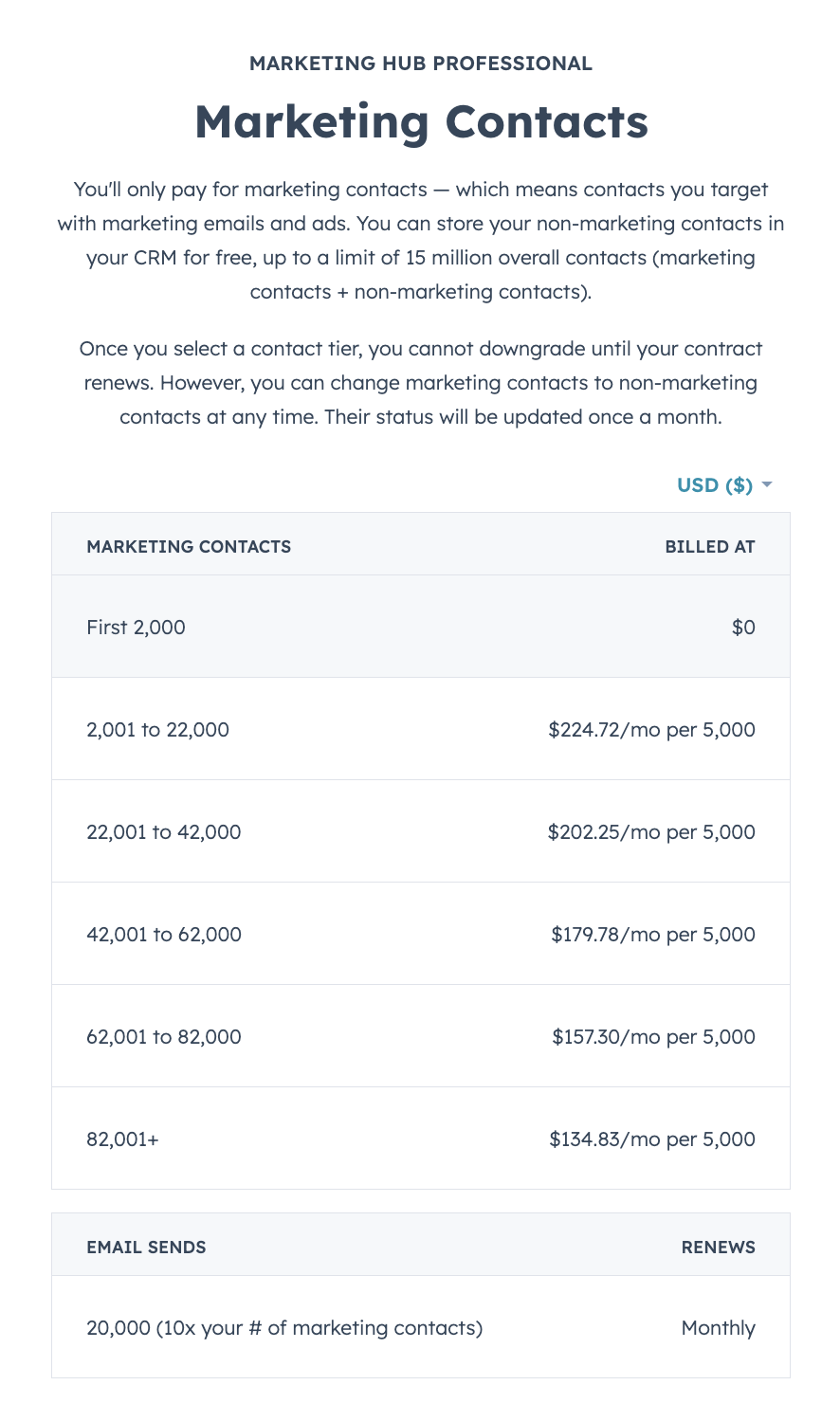
The biggest takeaway: Upgrade with caution and always remember to clean out unused contacts in your database.
Pro tip: If you’re a serious inbound marketer looking to automate some processes, the Starter tools are really only going to get you so far. You will be limited to 10 automated actions on forms and 10 automated actions on emails.
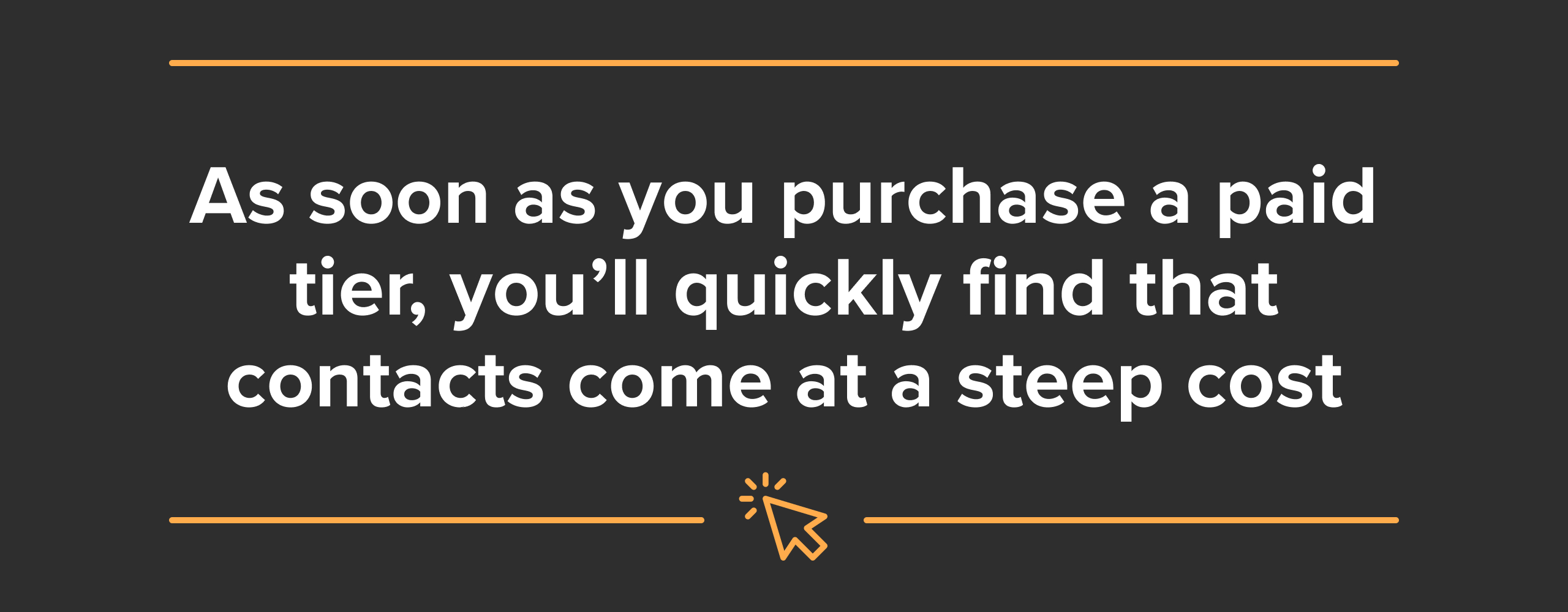
For smaller companies/teams or anyone just getting started with marketing automation, this could be just enough. For others looking to save time with more robust, automated experiences, you'll need to go to the Professional level.
Marketing Hub Starter is a great fit for: Small companies/teams (companies of 1-20 employees, marketing teams of 1) who want to get their feet wet with HubSpot’s basic functionality without making a major financial commitment, or companies who are just getting started with inbound marketing and want a tool that will grow and scale with their budding strategies.
If you already know you’re going to want marketing automation tools, customized reporting, and detailed tracking of your results, you’ll quickly hit your limit with Starter, and may as well just start at Professional.
Professional ($890/month + contacts)
Marketing Hub Professional includes 2,000 contacts at the $890/month subscription. For each additional 5,000 contacts, you’ll pay $250/month.
For example, if you have 5,000 contacts, you’ll pay $1,140 per month – that’s the base $890 + $250 for 5,000 additional contacts.
Pro is where it gets really good. While the Free and Starter tools are a great place to start for anyone who's just getting going with inbound marketing, HubSpot Marketing Professional is for the serious inbound marketer.
The Professional-level tools are where you can really start automating your processes, as well as creating and tracking content on the HubSpot platform.
The major added features above Starter include:
- Content tools
- Blog hosting
- Content strategy/SEO tools
- Social media publishing tools
- Calls-to-action (trackable buttons/graphics/links)
- Video hosting and basic reporting
- SSL certificate and subdomains (for hosting landing pages and/or blog articles)
- Automation and optimization tools
- Workflows (HubSpot’s automation engine)
- Smart content
- A/B testing emails and landing pages
- Custom reporting (up to 100 custom reports)
- Teams (creating your team structure in the tool and permission around teams)
- Salesforce integration (HubSpot’s only native CRM integration)
HubSpot Marketing Hub Pro is a great fit for: Any company serious about executing inbound marketing strategies, automating manual processes, and tracking the success of their digital marketing campaigns.
Enterprise ($3,600 + contacts)
Marketing Hub Enterprise was created for large marketing teams that will have a number of users and will need to partition the tool in different ways for different teams.
There are a handful of features in Professional that have increased limits when moving to Enterprise: 100 custom reports in Professional vs. 500 custom reports in Enterprise; 10 teams in Professional vs. 300 teams in Enterprise, etc.
Along with increased limits on different tools, the major added functionalities in Enterprise are:
- Multiple scoring properties
- Single sign-on (SSO)
- Custom attribution and event reporting
- Content partitioning
- CMS membership (restricting access to HubSpot-hosted pages)
- Hierarchical teams
- Account-based marketing tools
- Revenue attribution reporting
- Custom objects
Note: We go into much more detail about each of these features in our definitive guide to HubSpot for marketing. Check it out here!
Marketing Hub Enterprise is a great fit for: Large marketing organizations with multiple teams and lines of business that will need to easily partition different parts of the tools. Companies with large marketing contact databases (over 60,000) will save money on Enterprise, even if they don’t need all of the functionality.
Enterprise is also a great fit for marketing teams with more complex processes and advanced automation needs.
HubSpot Sales Hub pricing
The Sales Hub was HubSpot’s second major addition after Marketing Hub. It allows sales teams to track their activity and deals in the same place where all of their marketing data lives.
It uses the same exact CRM, which means if you’re using both the Marketing and Sales Hubs you’ll see activity for contacts throughout their entire lifecycle from the first touch to when a deal is closed.
Free
Like Marketing Hub Free, the free version of Sales Hub gives you an opportunity to try the platform before you buy it.
You’ll be able to set up one deal pipeline (with different deal stages) with easy meeting scheduling. You can manage your contacts and track when they’re opening and clicking on your emails, and even create up to five text templates and snippets to save time on the same types of one-to-one emails you’re sending all the time.
The free sales tools really give you a tiny taste of what the Sales Hub has to offer — we only recommend using the free tools if you’re a single user looking to improve productivity and track your own individual process better, since you won’t be able to customize the tools enough to make it work for a full sales team (or multiple teams).
Caveats to paid tiers
For both Sales and Service Hubs, you are allotted a certain number of users at the base pricing — two users for Starter, five users for Professional, and 10 users for Enterprise. That means if you want the Enterprise features, even if you’re a team of four, you’ll be paying for 10 seats.
Note: You will always be able to add an unlimited number of Free users.
If you have users that just need access to the database, but not to the added functionality of a paid seat, then you can always add them to your portal without a paid seat, and they’ll be able to access tools and functionalities that are in the free version of HubSpot (including your contact database).
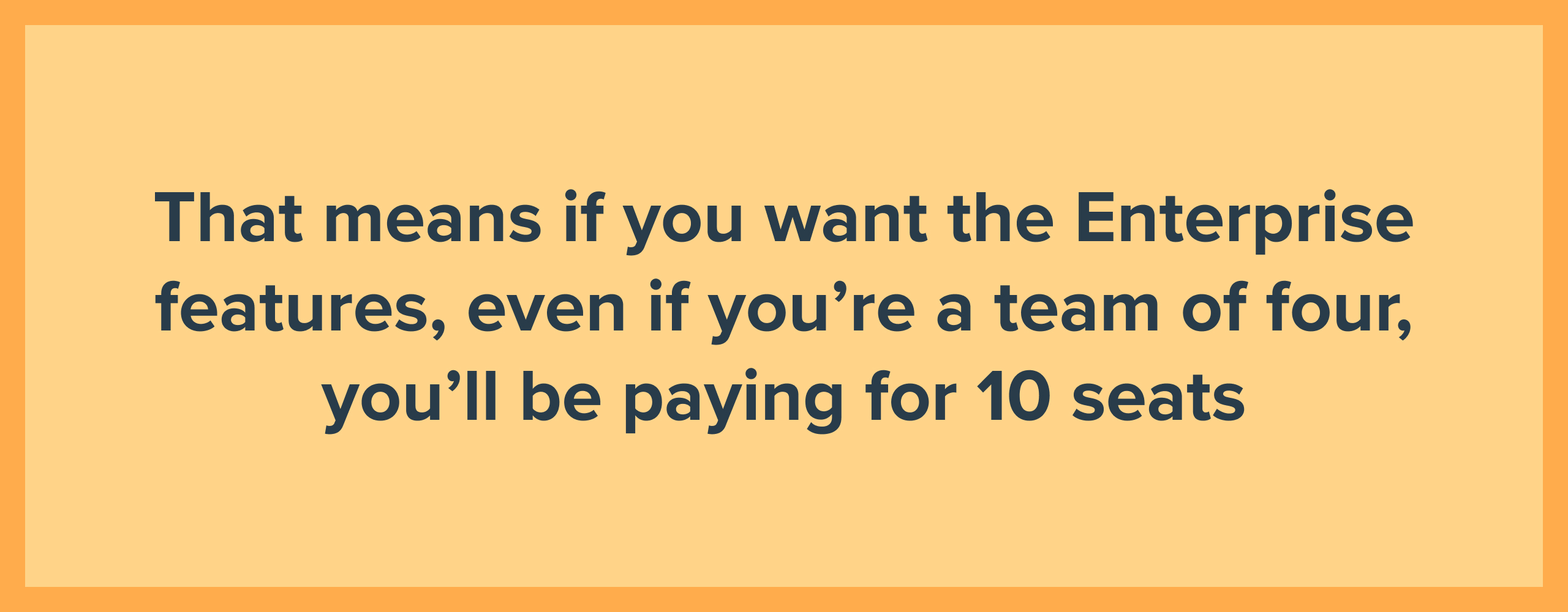
This means you really only need to buy paid seats for users who will be actively using the sales tools and needing access to advanced features.
Starter ($20/month — 2 users included)
Per the name, the Starter sales tools are a great place to get started with the sales platform if you’re not ready to make a larger financial investment and want to get some things set up before deciding whether or not to pay for the Professional or Enterprise tiers.
Here are the feature highlights:
- 1,000 email templates and snippets
- 1,000 automated email sequences
- Monthly revenue goal tracking
- 1 Conversations Inbox with team email
- 2 deal pipelines
- Conversation routing (assigning incoming chats and emails to individual users automatically)
Sales Hub Starter is a great fit for: Sales teams of one with no need for deal automation or custom reporting on sales productivity or pipelines. Again, it’s a great place to start if you want to try out some features and get your portal set up before investing in an upgraded level.
Professional ($500/month — 5 users included)
Like Marketing Hub, the Professional level is where you unlock the ability to automate manual processes and do custom reporting on your team’s processes.
Functionality highlights include:
- Up to 15 different pipelines (with different deal stages)
- Teams (up to 10)
- Automated sales email sequences
- Workflows (HubSpot’s automation engine)
- e-Signature (limited to 10 signatures per user per month)
- Product library and quotes
- 1:1 video creation
- Sales analytics (pre-built reporting on all kinds of different sales metrics)
- Custom reporting (up to 20 custom reports)
- Salesforce integration
- Stripe integration
- Slack integration
- Calculated properties
- Required fields for data management on deals
Sales Hub Pro is a great fit for: Sales organizations with 1-20 reps and one level of management.
If you’ve got many different sales teams with multiple levels of management, you’ll likely want to look at going Enterprise.
Enterprise ($1200/month — 10 users included)
Sales Hub Enterprise allows for more complex teams with sophisticated processes to be able to operate effectively in HubSpot.
Major functionalities that allow for that are:
- Hierarchical teams (mimic your team’s structure and set up permissions/assignments based on those teams)
- Playbooks (to enable your team to follow processes)
- Single sign-on (SSO)
- Webhooks (to pass information between HubSpot and other platforms)
- Quote-based workflows
- User roles (for managing high volumes of user permissions)
- Call transcription (English only)
- Recurring revenue tracking
- Custom Objects
Sales Hub Enterprise is a great fit for: Organizations with a large number of sales reps and managers who need a high level of configuration and governance over processes.
HubSpot Service Hub pricing
Free
HubSpot’s last version of “try it before you buy it,” Service Hub Free gives you access to set up one ticket pipeline, connect a team email (and manage that team email in one Conversations inbox alongside any of your live chat conversations), and look at canned productivity reports for your support reps.
Just like the free sales tools, the free service tools give you a small taste of what the Service Hub has to offer.
We recommend using the free tools if you’re a single user looking to improve productivity and track your own individual process better, since you won’t be able to customize the tools enough to make it work for a full customer service or support team (or multiple teams).
Caveats to paid tiers
All the same caveats as the Sales Hub exist here.
Starter ($20/month — 2 users included)
Like Sales Hub, Service Hub Starter will allow you to get your portal set up at a low cost, but unless you’re a super small team, it likely won’t give you enough functionality to be your solution long term.
Here are the feature highlights (look familiar?):
- 1,000 email templates and snippets
- 1,000 automated email follow-up sequences
- Basic monthly goal tracking
- 1 Conversations Inbox with team email
- 2 ticket pipelines
- Conversation routing (assigning incoming chats and emails to individual users automatically)
- 10 reporting dashboards
Service Hub Starter is a great fit for: Service or support teams of one with no need for ticket automation or custom reporting on team productivity or pipelines. Again, it’s a great place to start if you want to try out some features and get your portal set up before investing in an upgraded level.
Professional ($500/month — 5 users included)
Like Marketing and Sales Hubs, Service Hub Professional unlocks automation capabilities as well as custom reporting and additional pipelines. Plus, you get access to customer surveys and a knowledge base.
Here are the major added functionalities you get:
- Up to 15 different ticket pipelines (with different ticket statuses)
- Knowledge base (searchable content for answering customer questions)
- Logged-in Visitor Identification (see in Conversations Inbox if a user is logged in on your site)
- 1:1 video creation
- Net promoter score, customer experience, and customer support surveys
- Custom reporting (up to 20)
- Workflows (HubSpot’s automation engine)
- Teams (up to to 10)
- Slack integration
- Calculated properties
Service Hub Pro is a great fit for: Services organizations with 1-20 reps and one level of management. If you’ve got many different support or services teams with multiple levels of management, you’ll likely want to look at going Enterprise.
Enterprise ($1200/month — 10 users included)
Service Hub Enterprise allows for more complex teams with sophisticated customer service processes to be able to operate effectively in HubSpot.
Added functionality includes:
- Hierarchical teams (mimic your team’s structure and set up permissions/assignments based on those teams)
- Goals (set quotas for users and teams)
- Playbooks (to enable your team to follow processes)
- Single sign-on (SSO) and Knowledge Base SSO
- Webhooks (that pass information between HubSpot and other platforms)
- Quote-based workflows
- User roles (for managing high volumes of user permissions)
- Call transcription
- Custom Objects
Service Hub Enterprise is a great fit for: Organizations with a large number of support reps and managers who need a high level of configuration and governance over processes.
Is the HubSpot pricing worth it for you?
There are so many different aspects of functionality across all of the HubSpot Hubs that it can be overwhelming to wade through.
The most important thing is to decide what’s most important for your organization (not only for where you are now, but how you’re looking to grow), and make sure the level you choose gives you access to those capabilities.
Need help deciding what level of HubSpot to go with? Talk to us!


Order Your Copy of Marcus Sheridan's New Book — Endless Customers!
